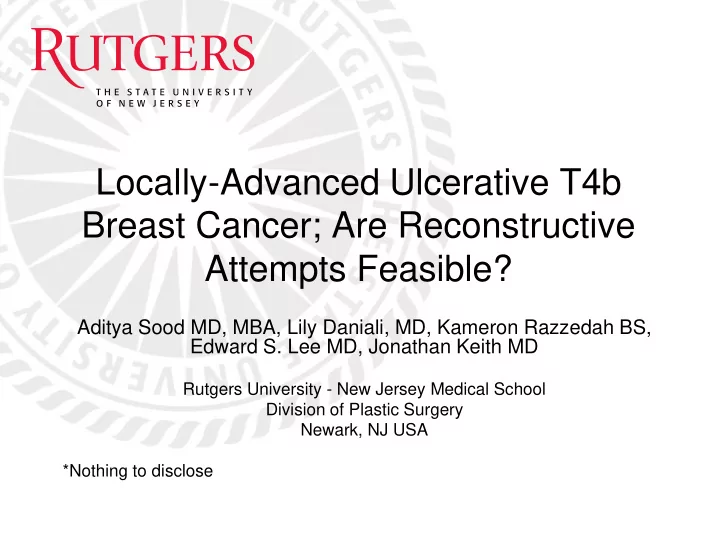

Locally-Advanced Ulcerative T4b Breast Cancer; Are Reconstructive Attempts Feasible? Aditya Sood MD, MBA, Lily Daniali, MD, Kameron Razzedah BS, Edward S. Lee MD, Jonathan Keith MD Rutgers University - New Jersey Medical School Division of Plastic Surgery Newark, NJ USA *Nothing to disclose
T4b Reconstruction Considerations Background • A subset of women with locally-advanced breast cancer (LABC) present with fungating tumor mass eroding and infiltrating the surrounding breast skin (T4b). – Present in 5-10% of cases in economically developed countries – 20-25% of cases worldwide • These patients often present with chronic pain, large open wounds, frequent infections, malodorous drainage, social isolation, and general debilitation that present enormous therapeutic challenges. • Optimal surgical management of LABC continues to be a source of controversy.
T4b Reconstruction Considerations Background cont. • Newark, NJ, USA (vs. total US population) – Total population 2013: 278,427 / 8,900,000 – Foreign born 2013: 26.9% / 20.8% – Primary language not English: 45% / 29.6% – Bachelor’s or higher 2008 -12: 12.5% / 35.4% 1. http://quickfacts.census.gov/qfd/states/34/3451000.html
T4b Reconstruction Considerations Materials/Methods • Single-center experience (IRB approved) • Retrospective review • 12 treated patients from 2011-2014 – Received reconstructive surgeries following resection of fungating T4b breast tumors
T4b Reconstruction Considerations Results Variable Value (%) • Table 1: T4b Fungating Breast No. of Patients 12 Tumor Patient Demographic & Social Characteristics Age, years Mean 52.6 Range 33-74 Race African-American 7 (50) Caucasian 1 (8) Hispanic 4 (33) Social History Recent US Immigrant (<2 years) 1 (8) Recent Homelessness (<1 year) 1 (8) Currently Unemployed 5 (42) English Speaking 5 (42) Living Alone 4 (33)
T4b Reconstruction Considerations Variable Value (%) Location of First Presentation Results cont. Emergency Department 3 (25) Charity Care Clinic/ Community Clinic 7 (58) • Table 2: Clinical Presentation & Pre- Private Office 2 (17) Chief Complaint on Presentation Operative Assessment of the Patient Open wound and/or skin involvement 12 (100) with a Fungating T4b breast tumor Pain 8 (66) Malodorous Drainage 3 (25) Breast mass increasing in size 3 (25) Patients Reason for Delayed Presentation Embarrassment 2 (17) Psychiatric Condition 3 (25) Prior Misdiagnosis 1 (8) Fear of Treatment 3 (25) Tumor Size Mean (cm 2) 810.2 <300 cm 2 6 (50) 300-600 cm 2 2 (17) >600 cm 2 3 (25) Hemodynamic Instability on Arrival 2 (17) Neo-adjuvant Chemotherapy 4 (42) Neo-adjuvant Radiotherapy 2 (17) Extent of Disease as Assessed by Imaging Loco-regional Spread 3 (25) Distant Metastasis 6 (50)
T4b Reconstruction Considerations Results cont. • Table 3: Pre-Operative Laboratory Characteristics Variable Mean SD Albumin 3.4 1.0 Hemoglobin 9.8 2.6 WBC 12.8 10.5 Platelets 316.9 139.8 INR 1.1 0.17 CRP 0.65 0.15 *Notably: Two patients had presented in shock, with one patient having a hemoglobin of 4.2
T4b Reconstruction Considerations Variable Value (%) Oncologic Management Breast Results cont. Modified Radical Mastectomy with Axillary Lymph 9 (75) Node Dissection Radical Mastectomy 2 (17) • Table 4: Characteristics of Oncologic Chest Wall & Reconstructive Management of T4b Ant pec major fascia resected 4 (33) Additional chest wall muscles resected 2 (17) Fungating Breast Tumors Pathology Breast specimen with clear margins (R0) 7 (58) Reconstructive Surgery Area requiring reconstruction (cm 2) Mean 473 >300 2 (17) 300-600 6 (50) 601-900 4 (33) Procedures Performed Thoracoepigastric Advancement Flap 4 (33) Latissimus Dorsi Flap 5 (41) Trapezius Flap 1 (8) Extended vertical & transverse rectus abdominus flap 1 (8) Split-thickness skin graft 6 (50) Timing of Reconstructive Surgery Immediate 10 (83) Delayed 2 (17) Total # of Reconstructive Surgeries 1 7 (58) 2 5 (41)
T4b Reconstruction Considerations Results cont. Value (%) Surgical Site at 6 weeks follow-up • Healed 7 (58) Table 5: Postoperative outcomes. Open wound requiring dressings 3 (25) Not reported 2 (17) Post-operative Pain Palliation Reduced pain 9 (75) Persistent or increased pain 2 (17) Not reported 1 (8) Post-operative Wound Palliation Improved wound qualities (odor, 10 (84) drainage) Unimproved wound qualities 1 (8) Not reported 1 (8) Adjuvant Therapy Chemotherapy 4 (33) Radiation 1 (8)
T4b Reconstruction Considerations Results cont. • Table 5c. Postoperative complications. Value (%) Persistent wound drainage 2 (17) Dehiscience requiring OR revision 1 (8) Infection requiring course of antibiotics 1 (8)
T4b Reconstruction Considerations Case 1 • 61 yoF, Haitian descent, presented to the clinic with pain of Right breast, arm, back pain. Found to have a 15 x 13.5 x 11 cm lateral breast mass with peu d’orange and ulceration. • Dx: inflammatory breast cancer with axillary lymphadenopathy and no distant mets. • Treatment: neo-adjuvant chemotherapy, MRM and LND • Wound: 884 cm2
T4b Reconstruction Considerations Case 1 cont. • Immediate reconstruction with a latissimus myocutaneous flap and reverse abdominoplasty. • Hospital stay 4 days, discharged with nursing care and outpatient chemotherapy. • Reported improved pain, no complications. • Postoperative survival: 294 days
T4b Reconstruction Considerations Case 2 • 38 yoF, Hispanic descent, presented to the clinic complaining of pain in her chest with movement of her arm. Found to have a left lateral breast ulcerative lesion measuring 9 x 8 x4 cm. • Dx: Invasive ductal carcinoma with metastisis. • Treatment: neo-adjuvant chemotherapy, MRM, LND • Wound: 300 cm2
T4b Reconstruction Considerations Case 2 cont. • Immediate reconstruction with advancement of local axillary skin and STSG 300 cm2. • Hospital stay was 6 days. Received postoperative radiation. • Reported improved pain, no complications. • Postoperative survival: living *One month postop
T4b Reconstruction Considerations Conclusions • LABC continues to be the presenting form of disease in a significant percentage of breast cancer patients. • Microsurgical breast reconstruction techniques are reliable and efficacious in palliating pain and reducing wound care needs in patients with fungating T4b breast tumors. • Fasciocutaneous flaps (thoracoepigastric) and latissimus dorsi myocutaneous flaps were the most commonly utilized coverage options in our cohort. • Non-English speaking, social isolation, and psychiatric illness all play a part in delayed presentation.
Recommend
More recommend